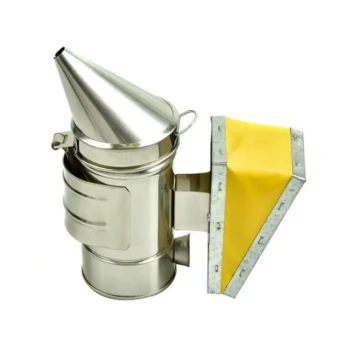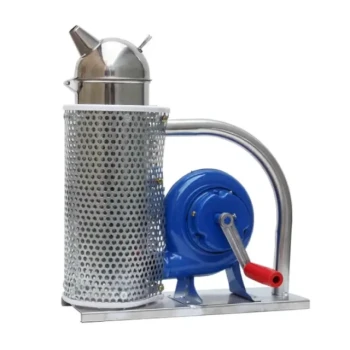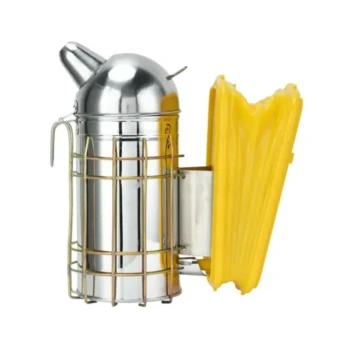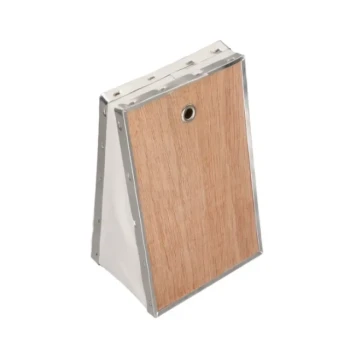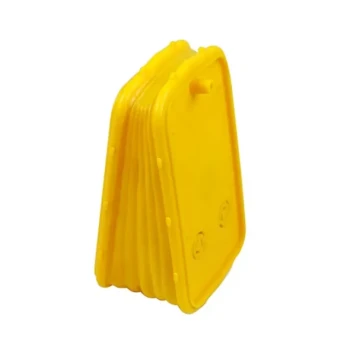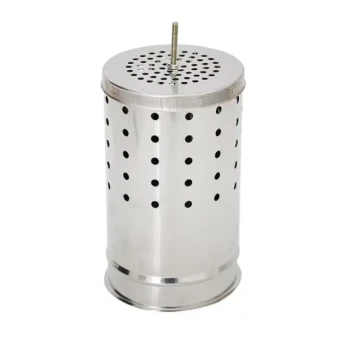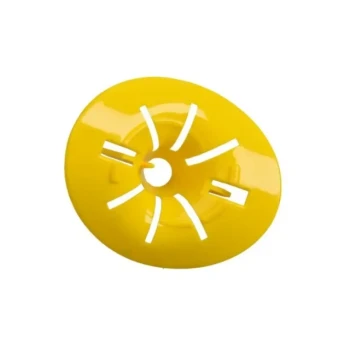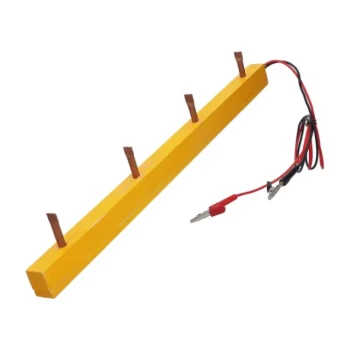To create effective smoke for calming bees, you can use a variety of natural, slow-burning materials. The most common and reliable fuels include dry pine needles, untreated burlap, rotten "punk" wood, and commercial smoker fuels made from compressed cotton. The key is to choose a fuel that smolders well and produces a cool, thick smoke rather than a hot, open flame.
The specific material you burn in a bee smoker is less important than its properties. The ideal fuel is always natural, completely dry, and capable of smoldering slowly to produce a consistent volume of cool, clean smoke that pacifies bees without harming them.
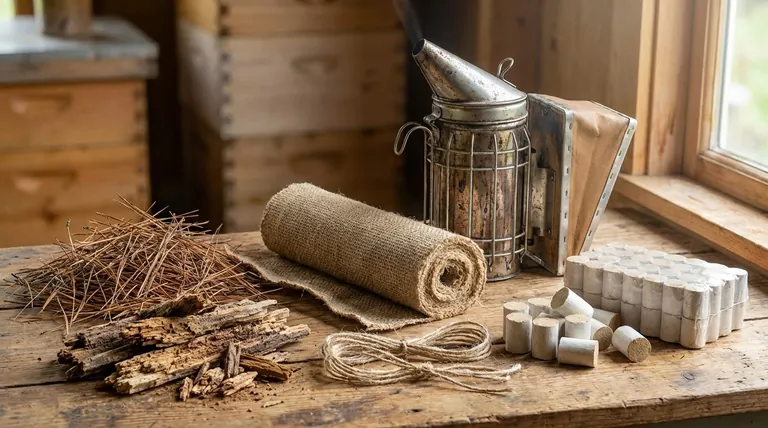
Understanding the Goal: Cool, Clean Smoke
Before choosing a fuel, it is critical to understand what you are trying to achieve. The goal is not simply to create smoke, but to create the right kind of smoke.
Why Smoke Calms Bees
Smoke effectively masks the alarm pheromones, such as isopentyl acetate, that guard bees release when they perceive a threat. This interruption in chemical communication prevents a hive-wide defensive response.
It also triggers a secondary feeding instinct. Bees associate smoke with a forest fire, prompting them to gorge on honey in case they need to abandon the hive. A bee with a full stomach is less agile and less inclined to sting.
The Anatomy of a Proper Smoker Fire
A well-prepared smoker doesn't have a roaring fire. It has a smoldering bed of coals that heats fresh fuel placed on top.
This is achieved by layering. A starter material is lit at the bottom to create embers. Then, a slower-burning primary fuel is added on top. The bellows pump oxygen to the embers, causing the primary fuel to smolder and release a thick, cool smoke.
Choosing Your Smoker Fuel
You can divide your fuel materials into two categories: starters to get the fire going and primary fuels to produce the long-lasting smoke.
Starters: Getting the Fire Lit
Starters are materials that ignite easily with a match or lighter. You only need a small amount to create a bed of coals.
Common starters include crumpled newspaper, untreated cardboard, paper egg cartons, or a handful of dry pine needles.
Primary Fuels: For a Long, Slow Burn
Once your starter is lit and burning well, add your primary fuel. These materials are denser and designed to smolder for a long time.
-
Wood-Based: Dry pine needles are a beekeeper favorite as they are widely available, light easily, and produce a pleasant-smelling smoke. Wood shavings and rotten, crumbly "punk" wood are also excellent choices.
-
Fiber-Based: Strips of untreated burlap (also called hessian) or natural twine are classic smoker fuels. They hold a smolder exceptionally well.
-
Other Natural Materials: Dried leaves, crushed and dried corn cobs, and cotton rags (100% cotton only) are also effective.
-
Commercial Fuels: You can purchase pre-made smoker fuels, which are often composed of compressed cotton or pulped paper. These offer consistency and convenience.
Common Pitfalls and What to Avoid
Using the wrong fuel or technique can be ineffective at best and harmful to your bees at worst.
The Danger of Chemical Contaminants
Never burn any material that has been treated with chemicals, contains synthetics, or is coated in plastic or gloss.
This includes pressure-treated wood, glossy magazine paper, dryer lint (which contains synthetic fibers), and polyester or other synthetic fabrics. The fumes can be toxic to your bees and contaminate your honey.
Avoiding "Hot Smoke"
A smoker with an active flame produces hot, thin smoke. This will not calm the bees; it will agitate them and can even burn their wings. If you see flames coming from the spout, add more fuel to smother the flame and produce a smolder.
The Problem with Wet or Green Fuel
Fuel must be completely dry. Damp or "green" material is difficult to light, smolders poorly, and produces an acrid, steamy smoke that is ineffective for calming bees.
Making the Right Choice for Your Goal
Your ideal fuel depends on your local environment, budget, and personal preference.
- If your primary focus is convenience and reliability: Use commercial smoker fuels like compressed cotton pellets for a consistent, easy-to-manage burn.
- If your primary focus is cost-effectiveness: Use natural, foraged materials like dry pine needles, rotten wood, or dried leaves that you can gather for free.
- If your primary focus is a long, slow smolder: Use dense fibers like untreated burlap strips or natural baler twine, which are known for their longevity.
Ultimately, mastering your smoker is about creating consistent, cool smoke to ensure a calm and productive hive inspection.
Summary Table:
| Fuel Type | Examples | Key Characteristics |
|---|---|---|
| Starters | Newspaper, Cardboard | Ignites easily to create a bed of coals. |
| Primary Fuels | Dry Pine Needles, Burlap, Punk Wood | Smolders slowly for long-lasting, cool smoke. |
| Commercial Fuels | Compressed Cotton Pellets | Consistent, convenient, and reliable. |
| Avoid | Treated Wood, Synthetic Fabrics | Produces toxic fumes harmful to bees. |
Ensure every hive inspection is safe and productive with the right equipment.
HONESTBEE supplies commercial apiaries and beekeeping equipment distributors with high-quality, reliable beekeeping supplies through our wholesale-focused operations. From durable smokers to premium protective gear, we provide the tools you need for success.
Contact HONESTBEE today to discuss your wholesale needs and let us help you build a calmer, more efficient operation.
Visual Guide
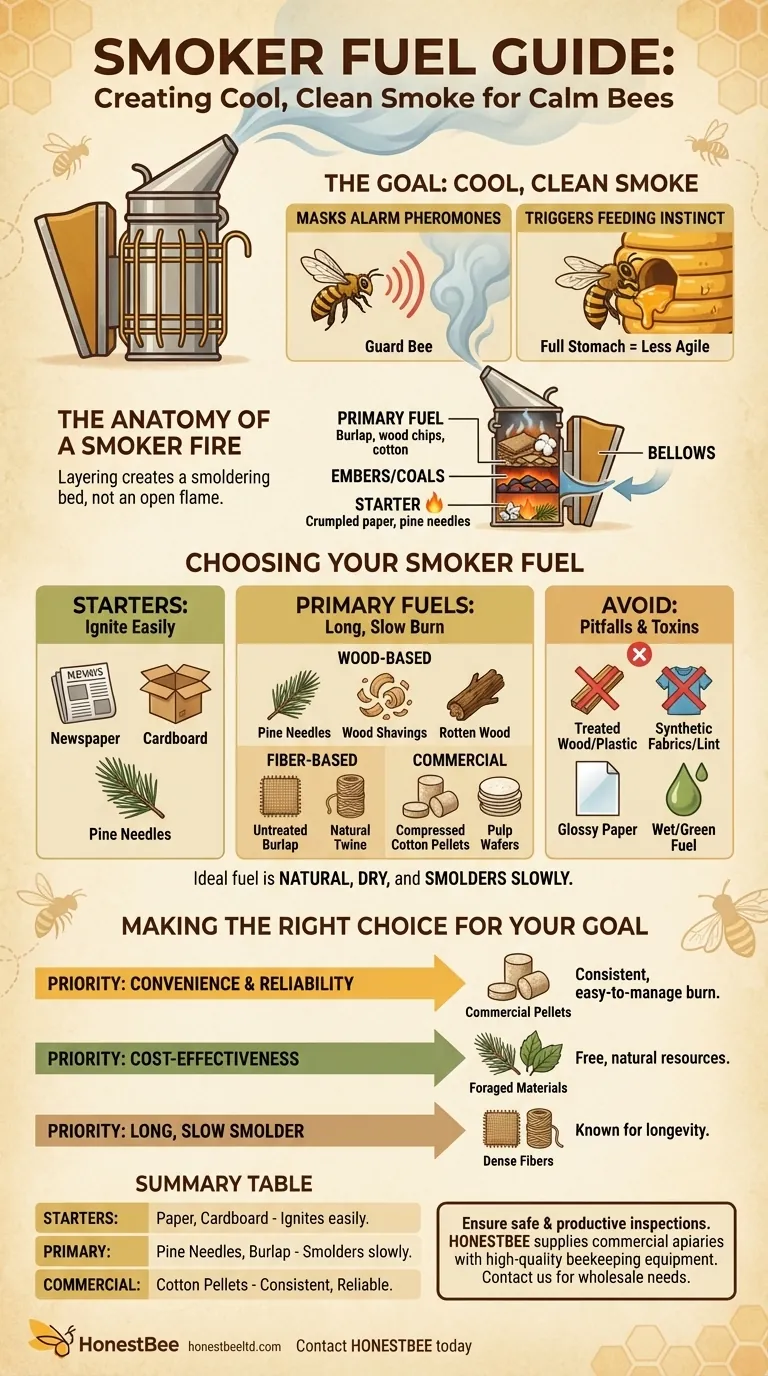
Related Products
- 54-Piece Smoker Fuel Pellets for Beekeeping Beehive Smoker Fuel
- Stainless Steel Honey Bee Smoker Hive and Honeycomb Smoker for Beekeeping
- Premium Traditional Copper Bee Smoker with Bellows
- Economy Galvanized Beekeeping Honey Bee Smoker for Wholesale
- Professional Bee Smoker with Elongated Spout and Durable Bellows for Beekeeping
People Also Ask
- What is used in a bee smoker? Master the Best Fuels for Calm, Healthy Hives
- What are important considerations when choosing smoker fuel? A Guide to Safe, Effective Beekeeping
- What is best to burn in a bee smoker? Master the Layered Fuel Technique for Calm Hives
- What is the best material for a bee smoker? Choose the Right Fuel for a Calm Hive
- What to put in a bee hive smoker? A Guide to Natural, Calming Fuels






